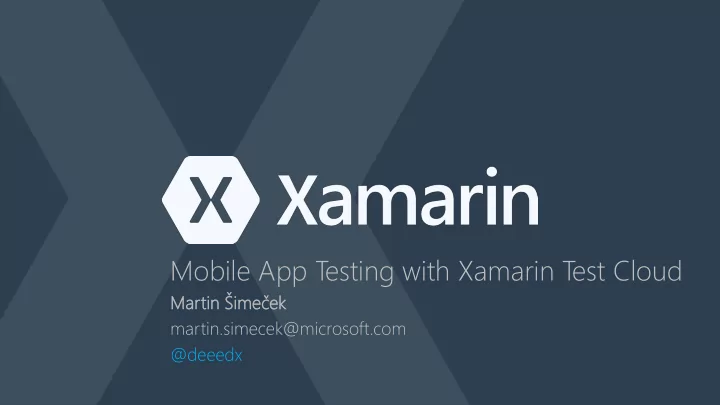

Mobile App T esting with Xamarin T est Cloud Martin Šimeček martin.simecek@microsoft.com @deeedx
Mobile Quality Challenges Device Fragmentation App Complexity Fast Release Cycles Short Sessions High Mobile User Expectations
Results! The Differences in Time to Value 19K unique 20 iPhone and In the United States, a business must test on Android devices iOS configuration available on the combinations on 134 different devices market the market to cover 80% of devices in use
The Manual Approach Limited device reach, based on user availability Slower and less accurate Delayed feedback collection Inconsistent
The Device Remoting Approach Prone to human error Limited test complexity No simultaneous testing slows time to identify issues
The Simulator Approach Limited real world applicability Virtual, not real devices Limited accuracy
Xamarin T est Cloud Approach Consistent, scalable and accurate tests Simultaneous testing across device platforms, operating systems and form factors Real usage scenarios, including complex gestures Secure with device wipe after each test run AUTOMATED WITH MANAGED DEVICES
Xamarin Test Cloud
Xamarin T est Cloud 2,000+ devices Automate your app testing and run them on over 2,000 different real devices. T est everything users do, as well as any performance problems with step-by- step memory and performance tracking. Real devices, real quality Ensure higher quality by testing on real devices • Automate app testing on over 2,000 real devices • Use C#, Ruby, or Cucumber to build automated • tests Integrates with any continuous integration system •
Examples of User Interactions Tap Scroll Swipe Multi finger Pinch GPS Text Entry Rotation
Visually compare test results against Review each step of a test hundreds of devices at a time case and compare visual results on all devices Zoom in and full screen resolution of all • screens Video playback coming in 2015 •
Access precise device specifications, full-size screenshots, and the native device log Understand CPU and memory usage during every step
Tests Adapt to UI Changes Object-level user interface testing Tests adapt as user interface changes
March 2015
How does it work?
Xamarin T est Cloud 1. Create a Xamarin T est Cloud account 2. Prepare tests 3. Deploy to XTC 4. Integrate with your release pipeline
1. Create Xamarin T est Cloud Account free trial – 30 days – max. 3 concurrent devices – max. 3 testing hours per day
DEMO Registering XTC account
2. Prepare tests UI T ests in a separate project using NUnit can be hand-written can be recorded using T est Recorder iOS tests cannot be run on Windows
REPL Read-Eval-Print-Loop useful when defining tests app.Repl() – stops running test and opens a console window tree – lists the current view‘s structure copy – copies all commands to clipboard
Commands (Methods) app.Flash() – „blinks“ an element – app.Flash(c => c.Class(„EditT ext“)) app.EnterText(c => c.Marked(„creditCardNumberText“), „12345“) – app.ClearT ext(...) app.Tap(c => c.Marked(„validateButton“)) app.WaitForElement(c => c.Marked(„label“).Text(„ABC“)) – 1 minute in test cloud – 15 seconds locally – can be changed with a parameter
DEMO Working with Xamarin REPL
T est Recorder available as a preview extension for Visual Studio https://developer.xamarin.com/guides/testcloud/testrecorder /visual-studio/
3. Deploy to Xamarin T est Cloud via web portal from Visual Studio / Xamarin Studio from command line
DEMO Deploy to XTC from VS
4. Integrate with your release pipeline Visual Studio T eam Services Xamarin T est Cloud as one of the build steps
DEMO VSTS & Xamarin T est Cloud
Mobile App T esting with Xamarin T est Cloud Martin Šimeček martin.simecek@microsoft.com @deeedx
Recommend
More recommend